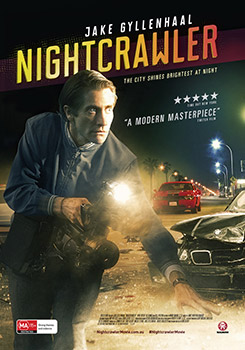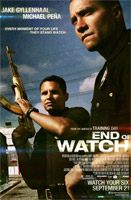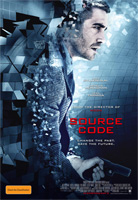Jake Gyllenhaal Nightcrawler

Jake Gyllenhaal Nightcrawler
Cast: Jake Gyllenhaal, Rene Russo and Bill Paxton
Director: Dan Gilroy
Rated: MA
Running Time: 117 minutes
Synopsis: Nightcrawler is a pulse-pounding thriller set in the nocturnal underbelly of contemporary Los Angeles. Jake Gyllenhaal stars as Lou Bloom, a driven young man desperate for work who discovers the high-speed world of L.A. crime journalism. Finding a group of freelance camera crews who film crashes, fires, murder and other mayhem, Lou muscles into the cut-throat, dangerous realm of nightcrawling - where each police siren wail equals a possible windfall and victims are converted into dollars and cents. Aided by Rene Russo as Nina, a veteran of the blood-sport that is local TV news, Lou blurs the line between observer and participant to become the star of his own story.
Nightcrawler
Release Date: November 27th, 2014
About The Production
Every night, while the city sleeps, motley crews armed with fast cars, expensive video cameras and blaring police radios prowl the sprawling Los Angeles basin in search of a story. These freelance stringers, known as nightcrawlers, hunt for crashes, fires, murder and other mayhem in hopes of selling the footage to local TV news. Pin-balling from one police scene to the next, they are driven by a simple equation that converts crime and victims into dollars and cents. For writer-director Dan Gilroy, the nocturnal subculture of maverick newshounds became the perfect world to launch lead character Lou Bloom. The embodiment of an alienated, younger generation, Lou faces a future in which internships and minimum wage have replaced the promise of full-time work and careers. 'What are the employment and advancement chances for Lou's generation when opportunities have vanished because of low-wage globalization?" Dan Gilroy wonders. 'This is the environment Lou's character springs from. He lives in a world of growing economic disparity. Closed doors. Internships creating indentured servants. That's the employment reality for Lou and for millions."
Seizing the opportunity to capture a snapshot of this Los Angeles subculture, Dan Gilroy began with several key character concepts. 'Lou is someone who doesn't change and instead bends the world around him," the filmmaker says. 'I saw it as a chance to create a character that holds a mirror up to society."
Lou's ascent in the realm of TV news is a classic American success story"with a dark twist. 'He starts off searching for work and ends up being the owner of a growing business. It's a happy ending for our hero but a nightmare finish for society." Dan Gilroy says he wanted to 'instill the awful knowledge that the real horror isn't Lou, it's the world that created him and rewards him."
The fine line for Dan Gilroy came in maintaining a connection between Lou and the audience by continually finding the humanity in the character. 'Lou's bible is the downloaded corporate scripture of multi-national companies, and he deeply believes," explains Dan Gilroy. 'Lou is always observant, soaking up things like a sponge and learning. These are relatable human qualities as is his fundamental quest to seek and climb. It creates empathy for his cause as he seeks a job and seeks a relationship. These qualities, combined with his loneliness, make Lou human."
Struck by the power of Dan Gilroy's screenplay, Jake Gyllenhaal came on board as both star and producer of Nightcrawler. During their very first meeting, Dan Gilroy and Jake Gyllenhaal agreed to take a collaborative approach to the material. 'It was always my intention to allow Jake Gyllenhaal the opportunity to really go to a place of intense exploration," says Dan Gilroy. 'He's such an extraordinary talent that I didn't want to stifle or impinge on his creative instincts."
Once Jake Gyllenhaal signed on to anchor Nightcrawler, casting director Mindy Marin assembled the rest of the ensemble, with substantial input from Dan Gilroy and Jake Gyllenhaal. 'Jake Gyllenhaal wanted very much to be involved in casting," explains Dan Gilroy, 'and I very much wanted him to be involved."
Nina The News Shark
Lou's ascent in the world of nightcrawling is aided by Nina, played by Rene Russo, best known for her scorching performances in The Thomas Crown Affair and Get Shorty. 'Nina is a veteran of three decades in the blood-sport that is local TV news," says Dan Gilroy. 'She's a 50-ish, over-made, hard-bitten beauty who began in front of the camera and has now, through sheer survival, become the madam of the whore house."
Dan Gilroy draws a key parallel between Russo's character and Lou's. 'Both come fully formed," he says. 'There's no transition in Nina other than the fact that her job is more secure at the end than at the beginning. The journalistic lines Nina crosses with Lou become more extreme but she's been crossing lines for years. By the end of the film, like Lou, she is rewarded for her choices."
Dan Gilroy wrote the part for Russo, his wife, 'because I knew she had it in her," he says. 'Rene has the amazing ability to show exterior toughness and internal sensitivity which was crucial for the character."
In a TV news environment where appearance often trumps substance, Russo's Nina had to convey the look of a woman who began in front of the camera and was now hanging on to her management position by her fingernails. Costume designer Amy Westcott conceptualised a wardrobe that harkens back to Nina's prime 20 years earlier as an on-air personality.
'We took a lot of reference from what would have been her heyday," explained Westcott. 'Women in her position often cultivate a look for themselves and keep it. Her look is feminine with a powerful edge because she's still trying to climb the ladder in a struggling newsroom. We also used a bit of sexiness in her wardrobe that is prevalent in female anchors in Los Angeles." Beneath the glamorous façade, Nina struggles to keep pace with a web-connected world where smart phones deliver infotainment around the clock. With hardly an iPhone in sight, Nina has become an endangered species on the verge of becoming an Old Media dinosaur. To compete, she stretches ethical boundaries to the breaking point and pushes Leo to bring her stomach-churning video. Nina's desperation comes through in her description of the station: 'Think of our newscast as a screaming woman running down the street with her throat cut."
Wingman
Jake Gyllenhaal was passionate about finding the right person to play his character's street-smart wingman Rick. 'We probably auditioned 60 or 70 people for the role of Rick and we had Jake reading with a lot of these actors," says Gilroy. But from the moment he saw Riz Ahmed's audition tape, Dan Gilroy believed the British actor of Pakistani heritage could deliver a nuanced performance as a homeless man desperate for a job. 'Riz stunned everyone with his first audition and then blew everyone out of the water the second time we auditioned him. Jake Gyllenhaal was there reading with Riz numerous times before we cast him."
To research his character, Ahmed spent time with homeless youth in Los Angeles. 'Rick's had this very tough life and he's had to deal with abandonment issues," says Ahmed. 'He latches onto Lou because he sees him as a kind of protector and mentor figure."
'Rick is a fundamentally decent person, but he's so downtrodden that his choices go against his better instinct." says Dan Gilroy. 'Like the other characters in the movie, Rick moves through a murderous world reduced to transactions. Lines get crossed and prices must be paid."
Local Tv News
Lou recites facts about the power of local television news and its appetite for fear-based crime stories. According to Dan Gilroy these facts are true. 'Despite falling crime rates, local television news creates and perpetuates the myth of urban crime creeping into the suburbs. Local television stories are teased with warnings. Crimes are falsely connected into patterns, suggesting growing and dangerous threats. News is packaged into a product intended to sell advertising."
Lou takes this programming credo to a new level as he hurls himself into his new career. Like everything else in his life, Lou approaches the job only after much research and preparation. Lou's pattern of speech is peppered with facts, self-help tips and business advice he's gleaned from the web. 'He's a strange combination of primal and modern society mixed together in this one human being," says Jake Gyllenhaal. 'He searches for hours upon hours on the internet to discover things about the world, right down to his word choices. Lou takes the information he learns as if it is written in stone. He always gets his point across, and everything he says has a real piece of truth in it." Or as Dan Gilroy describes it, 'Everything Lou says is an emulation of rote learning or perceived behavior all downloaded and honed to help him in the hunt to survive and acquire."
Lead costume designer Amy Westcott underscored Lou's predatory personality by selecting clothes that reflected his hunter-gatherer mentality. 'What's important about Lou is that he collects information and pulls things from different people based on the way he sees things. He has this sort of animal mentality, so in developing Lou's look it was more about finding a shiny object or color or something that would stand out to the character himself."
Jake Gyllenhaal describes Lou Bloom as a coyote. 'He searches and scavenges for whatever he can find," the actor says. 'He is hungry at all times and will destroy what he needs to if it stands in his path. He will succeed at any cost."
Thrill Of The Chase
The frenetic pursuit to find graphic news footage powers Nightcrawler's pulse-pounding action sequences. Dan Gilroy credits second-unit director Mike Smith for bringing those scenes to life with a world-class team of stunt drivers. 'You can plan something out as much as you want," Gilroy says. 'When you have three cars going 90 miles per hour down Ventura Boulevard in Los Angeles and you're about to crash them, you may think you know where they're going to land but you don't. It was amazing to watch Mike really dial it in and get the chase scenes where we wanted them to be. Some of the action was unexpected but in a really good way."
Dan Gilroy relied on production designer Kevin Kavanaugh to scout chase-friendly locations that would translate visually at 3 a.m. 'We did a lot of initial scouting at nighttime to gauge the street lights, ambient lights of the houses and the nature of the terrain," explains Kevin Kavanaugh. 'Then we closed down the streets for our big car chase and crash. Those are the fun moments you look forward to."
Dan Gilroy and his team shot Nightcrawler on the streets of L.A. primarily between midnight and 6 a.m. The hours proved taxing on both cast and crew but Jake Gyllenhaal found inspiration in the late-night schedule. 'I believe shooting at night helped bring out the subconscious," says Jake Gyllenhaal. 'I started thinking less and let my emotions get right there on the edge. I'm a real believer in the idea that all of the feelings you have and everything that's happening during production winds up being deeply embedded in each frame you watch on screen."
Risk And Reward
According to real-life stringers Austin and Howard Raishbrook, Lou Bloom comes across as a sociopathic stringer who embodies an extreme version of their own approach. Unlike Lou, they rarely blur the lines when it comes to the law. 'We will speed to get to scenes but we wouldn't do most of what this character does," says Austin.
In terms of the division of labor between Lou and Rick, however, Austin says Nightcrawler hews close to the truth. 'In the same way that Lou breaks up the job with Rick, we divide our roles where one of us will navigate and listen to the scanner while the other one concentrates on driving. And just like Lou and Rick, we also get into massive arguments."
In contrast to the eerily uncompassionate Lou, the brothers sometimes get emotionally shaken up by incidents they've encountered, as when they watched helplessly as a woman was burned alive in her car. 'We always have fire extinguishers and medical kits in case there's a situation where we can help," says Austin. 'Getting the shot comes secondary to any circumstance where we can do something."
Gilroy's Band Of Brothers
Nightcrawler marks Dan Gilroy's first turn in the director's chair after watching other filmmakers bring his six previous screenplays to life on screen. 'As a screenwriter on set, I've watched a lot of other directors work," says Dan Gilroy. 'You reach a point where you feel you're ready to try it yourself."
To produce Nightcrawler, Dan Gilroy recruited his brother Tony Gilroy, whose own efforts as a writer-director include the Oscar-nominated Michael Clayton. 'I was in a very advantageous place by having my brother Tony come on as the producer," says Dan Gilroy. 'Tony Gilroy's experience and position allowed him to run interference on a lot of crucial, elemental aspects of what we did, or were allowed to do."
Tony Gilroy co-produced the film with his longtime producer Jennifer Fox (Michael Clayton, Bourne Legacy). 'Jennifer Fox was invaluable in getting this to the screen," says Dan. 'In fact she was one of the first people to encourage me to direct. Jennifer Fox shepherded the script through casting, pre-production, and she was on the set every long night giving creative input and making sure we got everything we needed. Jennifer Fox's job was made all the more difficult by our budget and tight shooting schedule. What she managed and accomplished was amazing."
The director singles out his other brother, editor John Gilroy, and director of photography Robert Elswit as key collaborators. 'I was incredibly lucky to be able to work with them, Robert in production and John Gilroy in post," says the director.
Dan Gilroy and John Gilroy are twin brothers who collaborate very closely. 'It was just John Gilroy and me in the cutting room," says Dan Gilroy. 'John Gilroy has such a fine eye and command of the material. I'd hand him a complex sequence and what he came back with usually formed the basis for what's in the film."
Early support also came from producer David Lancaster, who responded to Dan Gilroy's script and championed the project for Bold Films. 'Dan Gilroy had a very strong and considered point of view for the film, which translated into him directing," David Lancaster says. 'He was very keen about the tone of the piece, which is very important for a film like this."
A Different Vision Of Los Angeles
The city of Los Angeles plays a major role in Nightcrawler. Dan Gilroy, who's lived in L.A. for 20 years, wanted to defy cliché perceptions of the city as a freeway wasteland. 'Los Angeles has a primal power and energy," says Dan Gilroy. 'Between the oceans, the mountains, the Santa Ana winds, earthquakes and fires, it has an elemental feel, an untamed spirit, especially at night. There's an intense beauty to L.A. as you come over a hill and see 20 miles through a glittery desert night." Few films have used the city more extensively, with the story taking place over 75 locations in L.A.
Cinematographer Robert Elswit used wide angles and a vivid color palette to capture Dan Gilroy's vision of Los Angeles as an island in the wilderness where man is an outsider. 'None of this would have happened without Robert Elswit," says Dan Gilroy. 'He brought so much from a production standpoint. His eye, his sensibility and unfaltering energy"Robert Elswit was there every moment creatively."
Production designer Kevin Kavanaugh (The Dark Knight) found locations in Echo Park, Angelino Heights and Downtown L.A. that captured the kind of untamed ambience rarely associated with big-screen portraits of the city. 'I wanted to show L.A. in a rolling hills, lush, overgrown kind of way," says Kevin Kavanaugh. 'There's a lot of foliage, old houses and hills in Los Angeles"very interesting parts of the city that you don't see too much."
Dan Gilroy notes, 'Kevin Kavanaugh found so many incredible locations I'd never seen before, but they were so right for the scenes." 'We worked very closely and Kevin Kavanaugh never failed in finding locations or the way he dressed the set. He really understood the material and creatively plugged into it."
Kevin Kavanaugh executed a story-driven color scheme that shifted to match the progression of Lou's career. 'When we introduce Lou he's driving a blue Toyota Tercel and we keep it there with blue tones in his apartment," says Kevin Kavanaugh. 'Everything is low tech as if he's 10 years in the past with his equipment. But then Lou gets the red Challenger and it's a whole different movie. When he makes that first bit of money and gains confidence, everything ramps up and the film becomes a whole new adventure at that point."
A Question Of Ethics
Nightcrawler portrays Lou as part of a supply-and-demand system in which local news stations hype crime reportage to boost ratings. 'It's the idea of selling fear to keep advertising rates up," says Dan Gilroy. 'Local TV news preys on people by instilling a pervasive feeling of peril." That said, Nightcrawler resists the temptation to point fingers. 'We always tried to stay cinematically neutral," say Dan Gilroy. 'We never underline any moral judgment. The film will hopefully say different things to different people. The aim is for viewers to see some part of themselves in Lou and the world he moves through."
Nightcrawler
Release Date: November 27th, 2014
Have You Seen This?
MORE
- Mission: Impossible Fallout
- Glenn Close The Wife
- Allison Chhorn Stanley's Mouth Interview
- Benicio Del Toro Sicario: Day of the Soldado
- Dame Judi Dench Tea With The Dames
- Sandra Bullock Ocean's 8
- Chris Pratt Jurassic World: Fallen Kingdom
- Claudia Sangiorgi Dalimore and Michelle Grace...
- Rachel McAdams Disobedience Interview
- Sebastián Lelio and Alessandro Nivola...
- Perri Cummings Trench Interview







